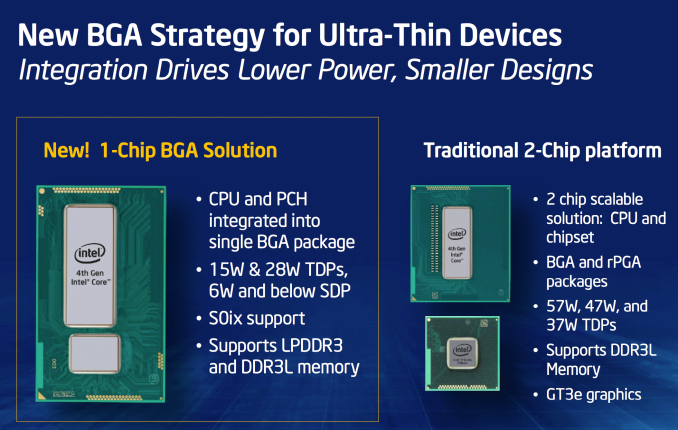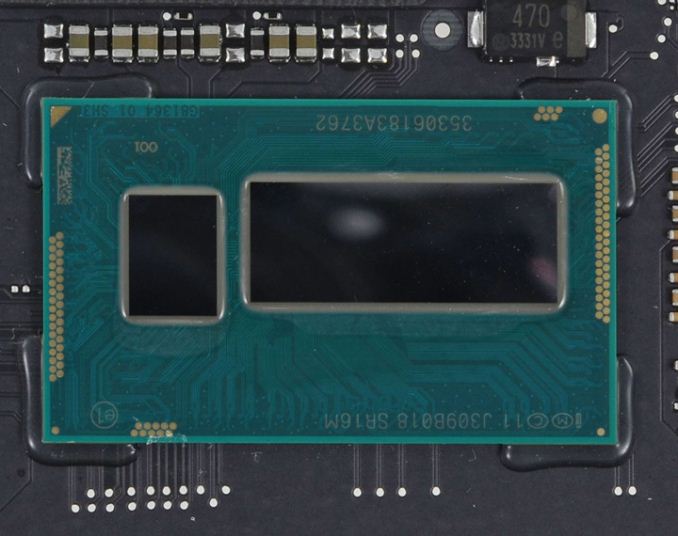The 2013 MacBook Air Review (13-inch)
by Anand Lal Shimpi on June 24, 2013 12:01 AM ESTThe CPUs
Apple keeps things simple across the 2013 MacBook Air lineup by configuring both 11 and 13-inch models with the same base CPU: a Core i5-4250U.
To understand Apple’s CPU choice, you have to understand that Apple is primarily concerned about improving battery life this generation. The line between MacBook Air and MacBook Pro has to be well defined. The Air is about portability, while the Pro is about performance. When faced with a power/performance tradeoff, it’s clear on which side of the fence Apple will fall whenever the MacBook Air is concerned.
| Apple 2013 MacBook Air CPU Comparison | |||||
| 1.3GHz dual-core | 1.7GHz dual-core | ||||
| Standard On | 11 & 13-inch MBA | Optional on Both | |||
| Intel Model | Core i5-4250U | Core i7-4650U | |||
| Base Clock Speed | 1.3GHz | 1.7GHz | |||
| Max SC Turbo | 2.6GHz | 3.3GHz | |||
| Max DC Turbo | 2.3GHz | 2.9GHz | |||
| L3 Cache | 3MB | 4MB | |||
| TSX-NI | No | Yes | |||
| TXT | No | Yes | |||
| AES-NI | Yes | Yes | |||
| VT-x/VT-x EPT | Yes | Yes | |||
| VT-d | Yes | Yes | |||
| TDP | 15W | 15W | |||
| Processor Graphics | Intel HD 5000 | Intel HD 5000 | |||
| GPU Clock (Base/Max) | 200/1000MHz | 200/1100MHz | |||
The lower base clock alone shouldn’t mean much, but the max TDP of the CPUs in the new MacBook Air falls as well - from 17W down to 15W. The thermal limit is even more dramatic since with Haswell ULT, the 15W includes the CPU/GPU as well as the on-package PCH. In Ivy Bridge the PCH was off package and wasn’t included in the 17W TDP.
Max turbo clocks are identical between the Haswell ULT CPUs Apple picked this round and the Ivy Bridge models before, but with a lower TDP it’ll be harder to always sustain the same frequencies given the right workload.
Haswell does feature a not insignificant gain in IPC compared to Ivy Bridge, which should help offset the power constraints that could otherwise force a larger regression in performance.
Both 2013 MBAs ship with the same CPU by default, and both can be upgraded to the same higher end SKU: a Core i7-4650U. The 4650U retains the same 15W TDP as the i5-4250U, but it increases its base clock speed to 1.7GHz and max turbo to 3.3GHz. The L3 cache also grows from 3MB to 4MB. All in all, this should be a very healthy upgrade in performance. Intel likely maintains the same TDP by binning for power; the i7-4650U is probably capable of running at higher frequencies without any appreciable increase in voltage. The max GPU clock also goes up by 10%.
Haswell ULT, Courtesy iFixit
What's arguably coolest about the i7-4650U is it enables Haswell's Transactional Synchronization Extensions (TSX-NI), a feature which is unfortunately disabled on the i5-4250U. I don't suspect this will matter much for most MBA users, but anyone looking to play around with Haswell's TSX instructions will want to opt for the higher end SKU. The upgrade costs $150 regardless of base model. Intel charges $454 for the i7-4650U and $342 for the i5-4250U, a difference of $112; Apple is adding another $38 onto the 1KU pricing, which isn't unreasonable.
Many have asked me what the impact of the i7 will be on battery life. I'm hoping to get my hands on an i7 based machine when I return from the UK in a week, but for those of you making immediate decisions I'll offer the following. Sustained operation at higher frequencies will likely draw more power, and negatively impact battery life. Light to medium workloads will enjoy a mix of race to sleep benefits as well as higher power consumption under load. Idle power should be roughly similar between the parts however. For most workloads I'd expect a modest impact to battery life, but it won't be enough to regress to 2012 levels of battery life. All of this is said without knowing key details like operating voltage for most 4650Us. I plan on addressing that shortly.












233 Comments
View All Comments
abazigal - Wednesday, June 26, 2013 - link
It's ultimately an issue of tradeoffs. Long battery life vs High quality display. I think between the 2, more people will opt for the longer battery life (considering it is an air you are getting after all).xTRICKYxx - Monday, June 24, 2013 - link
It shoulxTRICKYxx - Monday, June 24, 2013 - link
It should be 1680x1050KPOM - Thursday, June 27, 2013 - link
Scaling is an issue. Apple won't change the resolution until it can go "Retina" and quadruple it. OS X wasn't designed to scale at 150% like Windows Metro. No sense making a halfway move when the output won't look good. That's probably why Windows 7 notebooks stayed at 1366x768 for so long. Windows 7 itself could scale but most Desktop applications can't.spronkey - Monday, June 24, 2013 - link
To be honest, unless you go to *really* high res (i.e. "retina"), 1600x900 isn't really a large improvement on 1440x900, and anything higher than that becomes a little difficult to read without scaling, and ends up looking nasty. I personally think 1440x900 is a nice Mid-DPI resolution for these 13" machines.darwinosx - Monday, June 24, 2013 - link
It is for pretty much everyone as unless you go all the way to retina you get tidy text and icons.axien86 - Monday, June 24, 2013 - link
Not only that, but reading that Anand got the objectively better Samsung display instead of the LG display by luck of the "lottery" is one lottery that many buyers do not win.
Secondly, Anand describes Haswell THERMAL LIMITING and how it reduces performance, but how about simple measurements of important factors like CPU, GPU, keyboard and chassis temperature under load?
At other Mac forums, users with the new Macbook Air 2013 are finding many 3D games along with Flash/HD Youtube causes loud and irritating fan noise along with rapid dramatic rise in temperature.
No review of a ultralight laptop is complete without a complete noise and temperature analysis.
Synaesthesia - Monday, June 24, 2013 - link
Anand's reviews are the best. The 2012 and previous models had no issues with fan noise and heat generation, nor thermal limiting. The 2013 models with Haswell have much lower power consumption and heat generation will necessarily be much lower, so I'm sure it's great too, and that thermal limiting doesn't kick in at all.Synaesthesia - Monday, June 24, 2013 - link
Quoted from article: "For example, the fan was never audible on the 2013 MBA while running this test compared to running at a very noticeable volume on the 2012 Core i7 model. The same goes for temperatures. The i7 2012 model tends to run about 5% warmer along the bottom of the chassis compared to the 2013 i5."ddriver - Monday, June 24, 2013 - link
They are far too biased, but then again, so are you probably, if you find them "the best" you simply are on the same direction of bias.